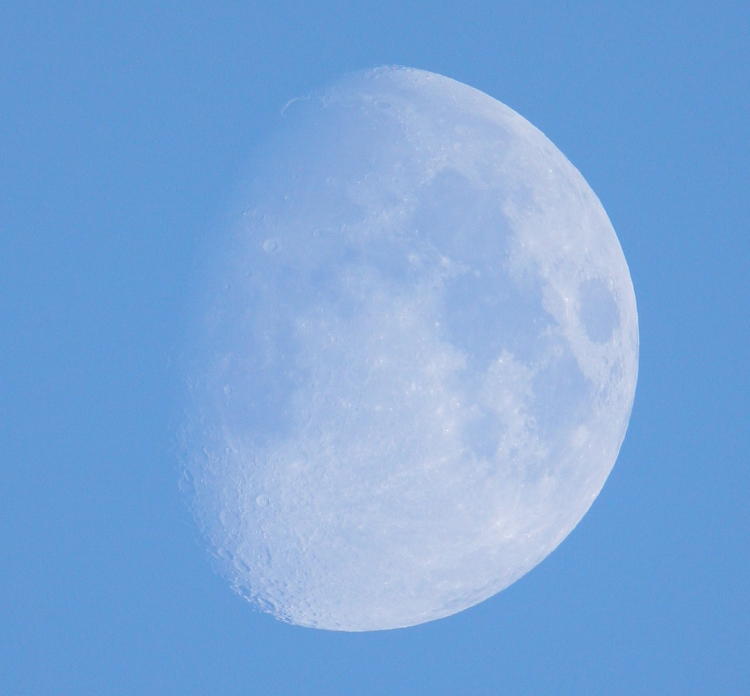
I had thought I was posting the most recent Storytime post so far, but I’d forgotten about this one. However, this is still pretty current, since most of the images are only a couple of days old.
I mean, except the one above. That’s a month old today, taken May 14th, in the same photo session as the osprey series. The osprey, as cooperative as they were, did not pose near the moon, but it occurred to me while I was out there that I had not tried the new lens with a moon shot, so I did a quick couple of frames then, intending to do a more serious approach later on. That chance came a few days back now.
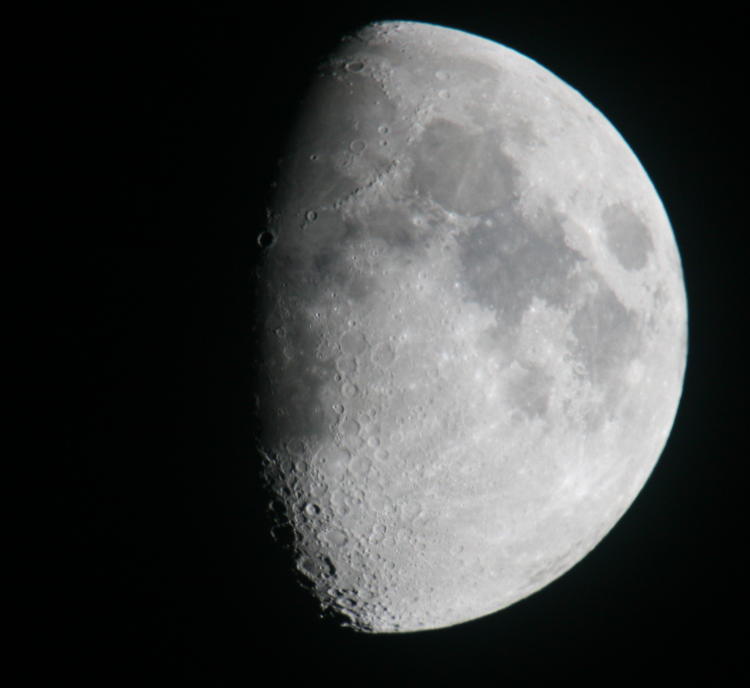
We’d had a lot of rain and overall yucky days, and visibility was nonexistent, but then we had a brief clearing spell and the moon was shining down brightly this past Tuesday evening. I did a couple of handheld shots, just to see how the lens stabilizer worked, but went back in and got the tripod to stop messing about. Now, I’ve mentioned countless times before about catching sunrise on Tycho’s central peak, which I eventually determined that I’d caught anticlimactically, without trying, many years before. And observing it Tuesday night, the chance was past by about a day. But that didn’t mean I couldn’t catch sunrise on Copernicus’ central peak!
 So let’s meet the players. Tycho is the one marked in blue, obviously well past sunrise now. Eratosthenes is marked in red, sitting at the end of the lunar Apennines mountain range, a nice distinct curve that, at the right times, is visible even by naked eye because of the shadows it throws. And so, marked in yellow and sitting on the terminator, that edge of light and shadow, we have Copernicus; larger than Tycho but a bit shallower I believe, so it is not as distinct because the shadows it throws are thinner. Still, it looked as if my timing might be right to catch the central peaks within the crater as the sun first touched them.
So let’s meet the players. Tycho is the one marked in blue, obviously well past sunrise now. Eratosthenes is marked in red, sitting at the end of the lunar Apennines mountain range, a nice distinct curve that, at the right times, is visible even by naked eye because of the shadows it throws. And so, marked in yellow and sitting on the terminator, that edge of light and shadow, we have Copernicus; larger than Tycho but a bit shallower I believe, so it is not as distinct because the shadows it throws are thinner. Still, it looked as if my timing might be right to catch the central peaks within the crater as the sun first touched them.
I say again, sunrise on the moon is a lot slower than on Earth, because of the moon’s orbit and rotation – a full lunar day is about 29.5 Earth days long, as opposed to 24 hours like ours. So sunrise moves pretty slowly, and timing can be a matter of hours instead of minutes. Copernicus’ central peaks are smaller than Tycho’s and less distinct, meaning that they might not even be visible without a telescope even in the best of conditions, but I was going to try anyway.
Some of these images, by the way, we taken with the 2x teleconverter attached to the Tamron 150-600, because I wanted to see how they performed together. Most times there is a little image degradation, and definitely there’s a loss of two stops of light, meaning a longer shutter speed and more time for vibration to affect the image. My teleconverter is 19 years old now, not at all matched to this lens, so probably not optimal, and initial tests indicate that it’s okay for non-critical uses, but not ideal. With a tighter tripod and a different subject, we might see slightly better results – more on that in a second.

Here’s a tight crop of the target area, Copernicus sitting right there almost in shadow, with sunlight hitting the far rim. We’re really not far away from the sun getting into the crater. So, I checked back in a little under an hour.
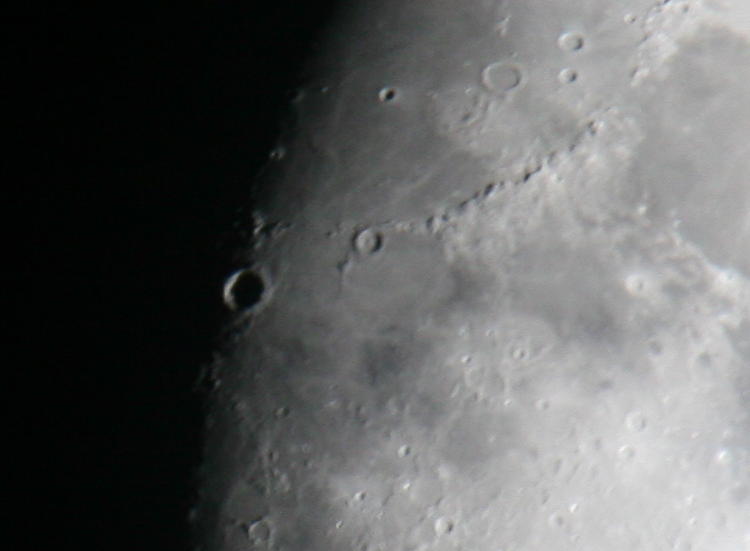
I was playing around with exposure during these, so this image is a little brighter exposed than the previous, which means that I can’t be sure just how far the sun has progressed across the lunar landscape – some of the difference may simply be due to getting in a little more light.
Moon exposures can be tricky. It’s lit by the sun with no clouds in between, so the exposure is more or less for full daylight – a lot faster than most people suspect. You still can’t trust autoexposure, unless you have a tight spotmeter reading only the moon. For a full moon, the exposure is f11, 1/[ISO], meaning if your ISO is at 250, shutter speed should be 1/250 second. But that’s a full moon; every other phase is catching the light more obliquely and exposures have to get commensurately greater, and I usually bracket shots (and focus, because it can be hard to pin it down in the viewfinder and autofocus is often untrustworthy in such conditions.) The exposure for the above image was f8, 1/40 second at ISO 400, but part of that was from losing two stops of light due to the teleconverter.
And then, fate struck, as is its wont. Actually, fate is striking constantly, isn’t it? Violent little cuss.
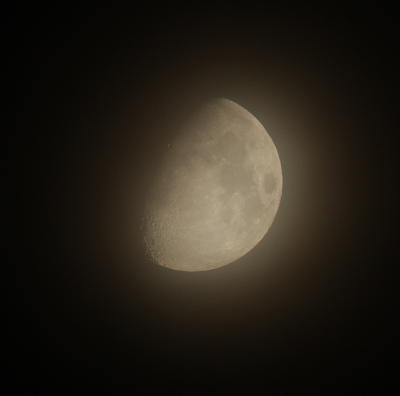 Almost two hours later now, the clouds had started to roll in – just a faint haze at first as the temperature dropped, but enough to obscure fine details on the moon. I watched for a little while to see if there might be a break in the clouds, but it looked solidly overcast to me, even as thin as it was – what would have turned the sky very pale blue to white during daylight.
Almost two hours later now, the clouds had started to roll in – just a faint haze at first as the temperature dropped, but enough to obscure fine details on the moon. I watched for a little while to see if there might be a break in the clouds, but it looked solidly overcast to me, even as thin as it was – what would have turned the sky very pale blue to white during daylight.
I want you to note the slight change in position in the moon now, rotated a little clockwise as it descended towards the horizon. Actually, it was facing the way it always had, but my camera was more oriented to the horizon and not the plane of the ecliptic, so we have what appears to be rotation perpendicular to the moon’s axis. I could have corrected easily, but who cares? It’s not like it would have made a difference to what I was after.
[By the way, I just wanted to point out a tiny bit of trivia. Within the Lord of the Rings movies, at times they show the moon in the sky, and to anyone that’s familiar with how it appears, it’s upside-down. Well, it is to those of us in the northern hemisphere, anyway. But since the movies were shot in New Zealand, the moon’s north pole points down towards the horizon instead of up. This is a vital clue as to where Middle Earth used to be located.]
Anyway, let’s go look at the detail, what there is of it.
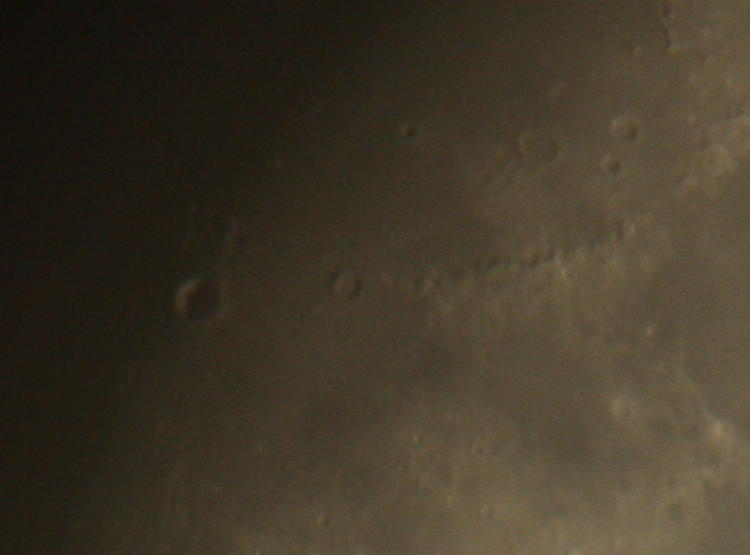
It still doesn’t look like sunrise has touched the central peaks yet, but I was expecting just a few pixels to betray the event in the first place, and it’s possible that it really was occurring and the minimal light was scattered into the haze. Regardless, the conditions were only worsening and it was clear (a ha ha) that I wasn’t getting anything further that evening – or morning, by that point.
By the way, if you want a nice detailed look at Copernicus, you can go here, and compare it against Tycho here (click on the images to see a bigger version.) And then, you can compare them against my successful attempt here, and note how trivial that spot of light appears in the best of conditions. As I said, I expect Copernicus’ peaks to be less visible when it occurs, so we’re pushing things here.
Now, while all of this was going on, I noticed that I was having some issues with the tripod not being perfectly steady, and eventually realized that the mounting plate at the top of the center column, to which the ballhead attaches, wasn’t fully secure. That began an attempted repair session, that I wasn’t successful at that evening/morning, partially because I knew I was going to need some power tools to complete it and wasn’t doing that at 2 AM. It also started me considering a new ballhead that performs a bit better, but I’m a cheapass and an Arca-Swiss or Novoflex ain’t happening, so the quest is the best bang for the least bucks. Then, out with a student yesterday, I started noticing that Shutter Priority mode on my main body wasn’t operating as intended, which is not a good sign. Part of the fun of such pursuits – repairs and replacements have to be part of the budget.
But I’ll close with a comparison shot, taken Thursday evening, so two days after the others (and a few hours ago as I type this ahead of time.) Those clouds rolling in Wednesday morning led to rain most of the day and evening, so no chances there, but it had cleared by Thursday late morning and I had the chance for further shots, pretty comparable in phase to the frame that opened the post (though much later in the day of course.) Copernicus is now well into sunlight, with the faintest of shadow from the central peaks, while Eratosthenes is throwing so little shadow that it’s almost indistinguishable – which is why full moon shots aren’t the best for detail and textures.

Oh, wait. I almost forgot – while out shooting that one, there were a couple of tiny little wisps of clouds that would pass by, and I caught a couple as they crossed the face of the moon, so I’ll include one of those for illustration too. It’s much better when it’s right alongside a clear shot.

And now, I’ll close. I’m in the middle of some projects, so more should be along shortly.




















































